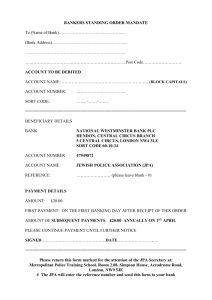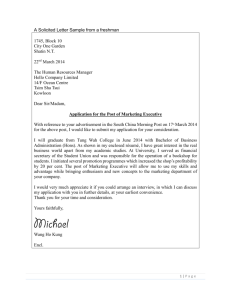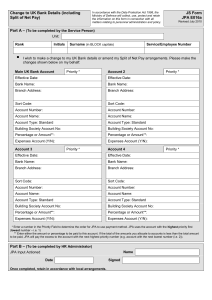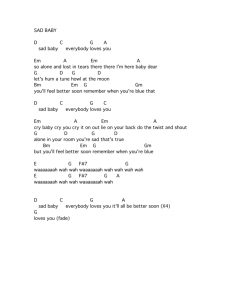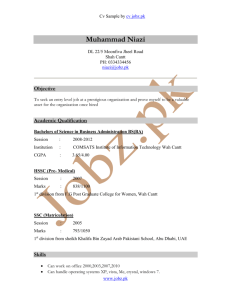Stage Crew L2A WaH Presentation
advertisement
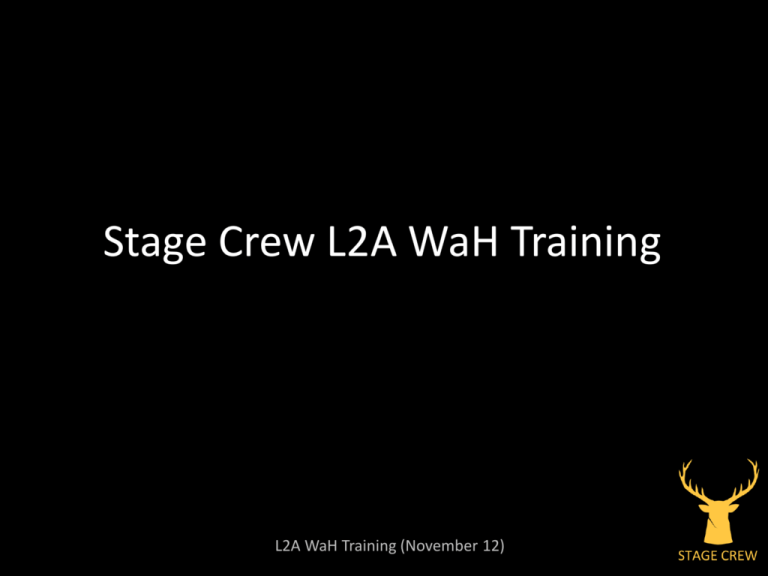
Stage Crew L2A WaH Training L2A WaH Training (November 12) What is the Aim of this course? • Enable you to be competent in the roof • Show that you have been properly trained in the considerations and requirements for working at height • Highlight the responsibilities and methods required to be safe • Teach you how to inspect the equipment for damage and some effective working methods L2A WaH Training (November 12) Course Structure • Theory & Demonstrations • Theory Test • Practical – Inspection – Ground work – T2 Working – Space-frame Working L2A WaH Training (November 12) Overview • • • • • • • • • • • • • WaH Regulations WaH in the industry Harnesses Helmets Work Restraint Work Positioning Fall Arrest Rescue PPE inspection What to take with you Rope work Rigging tips Risk Assessments L2A WaH Training (November 12) WaH Regulations • Work at Height Regulations – 6th April 2005 • Definition of ‘work at height’ – Work in any place including at or below ground level from which a person could fall. Obtaining access to or egress from any place while at work involving a risk of a person falling a distance liable to cause personal injury, but does not include access by means of a stairway in a permanent workplace. L2A WaH Training (November 12) Regulations • • • • Regulation 4: Organisation and Planning Regulation 5: Competence Regulation 6: Avoidance of risks Regulation 7: General principles for selection of work equipment for work at height – Part 2: Equipment selected by employer must be appropriate • • • • • • • • Regulation 8: Requirements for work equipment Regulation 9: Fragile Surfaces Regulation 10: Falling Objects Regulation 11: Danger Areas Regulation 12: Inspection of work equipment Regulation 13: Inspection of places of work at height Regulation 14: Duties of people at work at height Regulation 15-19: Armed forces exemptions L2A WaH Training (November 12) Regulations - Summary • Like LOLER (Lifting Operations and Lifting Equipment Regulations. more in L2B) • The planning should include emergency planning and rescue plans • Employers must ensure people are competent and supervised • It is the duty of employers to make sure that work actually needs to be done at height • Equipment should be selected by considering collective protection measures in preference to personal protection measures • Employers should ensure that objects or materials cannot fall from a height • The regulation also contains the phrase "Every employer shall ensure no material or object is thrown or tipped from a height in circumstances where it is liable to cause injury to any person • Identify areas where people might fall a distance or where objects may fall and strike people • Generally all equipment used in work at height must be inspected at 'suitable intervals' particularly equipment likely to be damaged from normal use, i.e. slings, grillons • Inspections must be carried out by a competent person, so we get someone in to check the WaH kit every 6 months • We also checkL2A everyWaH item Training before EACH use (November 12) WaH Pyramid Fall arrest systems Use access platforms Bring work to you Avoid work at height L2A WaH Training (November 12) WaH in the industry • Ladders • Access equipment – Scaffolding towers – MEWPs • • • • Grids Alcohol and drugs Planning the work Safe systems of work L2A WaH Training (November 12) Harnesses • Pre use check • How to put it on • Uses: – Work restraint – Work positioning – Fall arrest L2A WaH Training (November 12) Helmets • Pre use check • Putting it on – adjusting L2A WaH Training (November 12) Carabineers • Pre use check – Does it open and lock • Axis of load • Always lock L2A WaH Training (November 12) Work Restraint • Harness takes no load • Unable to get into the position where a fall is possible • E.g. – Working on a roof L2A WaH Training (November 12) Work Positioning • Supported by the harness • Generally positioned hanging next to the work L2A WaH Training (November 12) Fall Arrest • Not taking load in normal use • Must always have a connection • Y-Lanyards L2A WaH Training (November 12) Fall Arrest • Rope grab – ASAP – Rocker L2A WaH Training (November 12) Fall Arrest • Fall factor L2A WaH Training (November 12) Fall Arrest • Fall distance L2A WaH Training (November 12) Rescue Plan • • • • • • What if things go wrong? Always have a plan Rescue using ladder Rescue using genie Rescue by going up there Do not work at height without a rescue plan L2A WaH Training (November 12) PPE Inspection • Pre use checks • Regular inspection L2A WaH Training (November 12) Using Wire ladders • • • • • Few different ways to climb Some people like them footing, some don’t Usual access method to access gantries Uses vertical running line with Rocker or ASAP Take care with: – Twisted rungs (usually at bottom) – Lacing hooks on boots (can hook onto wire) • Don’t rely on these ladders as an escape route unless you have relevant competence and confidence L2A WaH Training (November 12) Using Gantries • They are ‘safe’ work areas like grids • No loose items in pockets • No need for a harness once in the gantry, unless: – There are parts of the floor missing, or you are removing bits of floor – You are leaning out through/below the handrails – You are climbing on the handrails • Do not leave holes in floor unless they are obvious • Do not trap cables in floor – tape/hang them from the handrails • Don’t use the window-sills • (e.g. to walk between gantries) L2A WaH Training (November 12) Using the Space-Frame • • • • • • Use fall-arrest lanyards on lower box section Nothing in pockets Can sit in nodes No drinks Always keep your rope Access via the gantries L2A WaH Training (November 12) Using the T2 Truss • • • • • • Access via wire-ladder Grip provided on all four cords for walking Four locations for attaching puzzle-blocks Maximum of two people Be careful of hot or fragile lights Ideally walk on the opposite side to the one your fall-arrest lanyard is attached to L2A WaH Training (November 12) What to take with you? • As little as possible, but it is a good idea to have a: – Harness – Hard-hat – Y-Lanyard Absorbica – Grillon – Rope L2A WaH Training (November 12) Rope Work • WaH usually means doing some rigging • With a rope you can get anything you need into the roof very quickly • Keep it tidy! • Make sure you can always let go of the rope if it gets caught • Pulleys make life easier L2A WaH Training (November 12) Rigging Tips • Baskets are most common – we will do some later L2A WaH Training (November 12) So even after all this, you forgot the ladder? L2A WaH Training (November 12) Theory Test L2A WaH Training (November 12) Practical Stuff …or some more training now, practical later L2A WaH Training (November 12)
